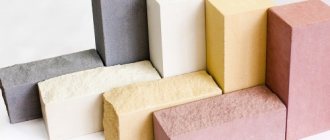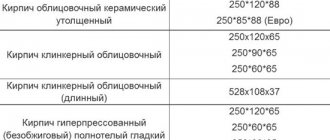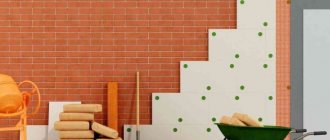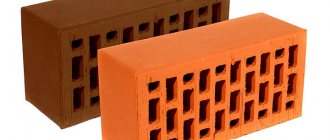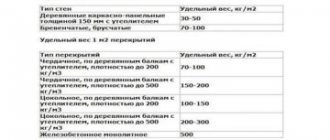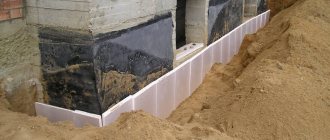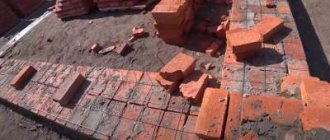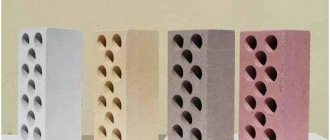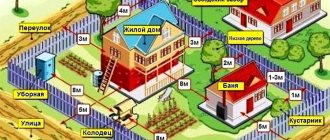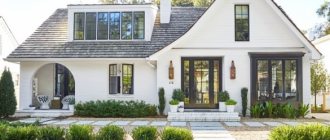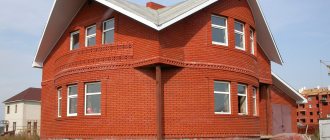Brick is considered the most reliable material for external cladding of facades.
The material is distinguished by its strength, ability to withstand external influences of an aggressive environment, durability and environmental friendliness.
Brick material can have different compositions, and therefore the color of different types differs from each other.
Also, depending on the composition, the brick has different properties, prices, and characteristics.
To decorate the structure in a non-standard version, yellow brick is used.
Description of yellow facing brick
Yellow brick for the facade is a fairly popular type of facing brick products, as it creates a feeling of light and warmth, creating a great mood even on gray rainy days.
The production of the yellow species involves the use of various types of raw materials, which determines the variety of color shades of this species.
The yellow type contains the following elements:
- high quality clay;
- lime;
- sand;
- water;
- iron oxide pigment.
The production of this type consists of pressing a mass of the above substances under high pressure, due to which the material is provided with frost-resistant characteristics, as well as hydrophobic properties.
Since natural substances are used in production, and there are quite a few additional components and impurities, this material is environmentally friendly and harmless to health..
After pressing, the material is fired and, if necessary, glazed.
It is the yellow look that is distinguished by the correctness of its shape: each element is made in the shape of a right parallelepiped with a clear outline of the edges and even corners. In addition, any shade of color is resistant to fading. Elements of a yellow hue have a meager variety of shapes and textures, but they differ in many shades precisely in the yellow segment of the palette.
IMPORTANT!
When purchasing facing bricks, you should choose material from one manufacturer.
In addition, you should purchase goods from one batch, since the color of different batches may differ slightly, which will affect the appearance of the cladding.
Photo of a yellow brick house:
House made of brown and yellow ceramic facing bricks produced by Stary Oskol
The house is lined with Stary Oskol bricks in mocha color and straw. If the bricklaying technology is followed, even on dark brown bricks no efflorescence appears and the masonry turns out uniform and has a beautiful chocolate color. This proves the high quality of facing ceramic bricks produced at the Stary Oskol Brick Factory
Advantages and disadvantages
An undeniable positive property of yellow brick is its decorative effect. A house whose façade is made of yellow brick will always stand out among other buildings.
In addition, this material has other advantages:
- good sound insulation;
- color fastness . The coating does not fade and is not exposed to sunlight;
- does not require special care, does not attract dirt, and also prevents the formation of mold or fungi;
- frost resistance. This type of cladding can be used in any region, regardless of temperature;
- strength . When exposed to any mechanical and impact actions, the cladding remains unchanged, does not deform, does not crack;
- resistance to any weather conditions. Rain, hail, and strong winds cannot negatively affect brick cladding;
- hydrophobicity. The production technology ensures the material is moisture resistant and incapable of absorbing moisture;
- fire resistance . Brick does not burn and does not support combustion in any way, does not ignite or melt;
- environmental friendliness. Due to the use of natural components in manufacturing, brick cladding is absolutely harmless to humans;
- durability _ The cladding may not lose its properties for many years; in comparison with suspended facade structures or decorative coatings with plaster or paint, it is the most durable and wear-resistant.
The disadvantages of brick cladding include cost, since the material is quite expensive compared to other types of external cladding . In addition, yellow brick is not varied enough in shape: the main element of the yellow type is a parallelepiped.
Brick photo:
House made of straw-colored brick with brown inserts produced by OSMIBT Stary Oskol
The facade of the house is made of straw-colored ceramic bricks, yellow-pinkish in color, which goes well with the brown roof. Brown brick inserts are made for contrast
Apricot and peach colored facing brick
The decorative component is almost the main priority of facing materials, and only then the technical characteristics are considered, so manufacturers of yellow types of brick products are trying to expand the range of color solutions.
The color is influenced by the type of clay, pigment, and the properties of iron in the clay . The professionalism of the manufacturer and the firing method are important, since the similarity of colors across batches depends on this.
Among yellow shades, apricot and peach are the most popular: the shade is quite warm. Using this color, you can not only cladding the façade advantageously, but also use elements of the material to lay out various pattern combinations. Apricot and peach go well with gray, brown or straw shades.
In addition, windows or individual parts of the facade can be decorated with warm-colored details..
The peach-apricot color is ideal not only for finishing multi-story facades, but also advantageously emphasizes the practicality of one-story houses.
Red brick cottages: timeless classics
The red brick facade looks equally good on small cottages and spacious country estates. A universal color suitable for implementing any design ideas.
Classic red brick combined with stone
Cozy house with large windows
Miniature cottage in red and white colors
Well maintained luxury of country living
Specifications
In accordance with the standard, manufacturers must adhere to the basic characteristics of the yellow type of facing brick:
- surface type - smooth, glossy or matte;
- product length - 25 cm (standard);
- product width - 12 cm (standard);
- height - 8.8 cm (standard);
- weight of one element - from 2.2 to 3.5 kg;
- strength marking - from 100 to 200;
- hollowness - from 30% or more;
- water absorption - no more than 20%;
- thermal conductivity - 0.4 W/ (mC).
There are non-standard types (European) of facing elements; they may differ in width, length, height. This does not affect the quality of the product in any way. Many European manufacturers (Finnish, for example) even win in terms of quality, but the cost of the material is several times more expensive than domestic ones .
Multi-storey and high-rise buildings made of facing ceramic bricks produced in Stary Oskol
The high technical characteristics of Stary Oskol brick allow the construction of high-rise multi-storey buildings with a beautiful facade that will not require repairs for many decades. And the impeccable appearance and aesthetic appeal of ceramic bricks gives creative freedom to designers and finds application in modern architecture. Visit the Façade Constructor and assemble the facade of your house from straw-colored and ivory-colored facing bricks. You can highlight corners and other decorative elements with chocolate-colored bricks. And also compare the shades of smooth and textured brick and you will see what the facade of your future home might look like
Other types of facing bricks
Facade bricks come in different varieties based on production technology, color, shape, filling, and size.
If we consider each parameter, we can classify the material as follows:
- according to the material of manufacture - ceramic, silicate, hyperpressed, clinker;
- according to filling - full-bodied and hollow (lightweight);
- by type of front surface - smooth, embossed, as well as matte or glossy. The texture may include engobe (ceramics), mineral chips, glaze;
- in shape - rectangular, with curves on one or both sides of the element of various degrees, with side cuts, bevels of different degrees, with a profiled surface, semicircular, with convex surfaces for decorating corners, cornices, openings, protrusions.
Regardless of the composition of the facade cladding, its color range is very diverse: from white to dark brown and black . The color does not affect the quality of the material, since natural coloring pigments are used.
Silicate varieties of building materials
For their production they use:
- lime;
- quartz sand;
- plasticizers;
- additives.
This composition ensures safety and indicates the environmental friendliness of the material.
One-and-a-half (silicate) yellow brick is made from 10 percent lime and 90 percent sand and is subjected to steam and high-temperature treatment. This method is called autoclave. Products made from this material get their color depending on what dyes were used. As a result, the shades of brick can be very different.
There are 2 types of silicate brick products for facade finishing:
- Double. Provides high thermal insulation;
- Front with decorative surface. Provides excellent appearance.
A significant feature of finishing with silicate products is that they do not tolerate high humidity and low temperatures. Therefore, this option will not be relevant for every territory of our country. For example, in northern regions, as well as those characterized by high groundwater, this type of finishing material is completely unsuitable. There it is more advisable to choose a ceramic analogue. Under the same conditions, it will provide the same properties as silicate building materials and will last much longer. That is, for them the best solution is ceramic one-and-a-half bricks.
Manufacturers
To ensure that batches of yellow and its shades do not differ, you should adhere to a special firing technology, use certain dyes and have high-tech equipment. Not all brick manufacturers produce yellow facing bricks.
Popular businesses are:
- Golitsyn ceramics plant;
- Zheleznogorsk brick factory;
- LSR. Wall materials;
- Markinsky brick factory;
- Kirov brick factory.
NOTE!
When purchasing material from distributors and factory dealers, you must check the certificate confirming the status of an official representative from the manufacturer.
Otherwise, there is a risk of running into low-quality material..
Brightly colored straw and ivory facing brick produced by OSMiBT Stary Oskol
Sometimes the Stary Oskol brick factory produces straw bricks of a dark shade, which also finds its consumer. But basically the manufacturer tries to adhere to the selected standards
Methods for choosing colors
Although the white facade was popular, it is a thing of the distant past. Nowadays, the majority of owners of private houses give their preference to original color solutions that can not only please the eye, but also be more resistant to external factors such as rain, snow and dirt. This approach entails modifications in relation to the choice of roofing material and its color. In order for the colored facade of the house to look harmonious, it is necessary to choose a roof color that can complement this picture and fit into the surrounding landscape design.
The main rule to remember is that you can’t rush. Before starting the construction of a private house, you need to draw up a project, add all the components and additional elements to it. In order to see a visualization of the finished house, you need to contact a construction company. Designers and architects, using modern computer programs, will be able to create a three-dimensional model of the future home, after which they will give freedom of action in choosing colors. Online you can choose the most suitable combination and see how the house will look in one color or another.
The visual perception of a house can be affected not only by the color of the facade or roof, but also by the type of lighting that will be used, as well as the texture of the roof surface. There is no need to rush when purchasing building materials; first, you can see how this or that type of roofing material will look on the roof, after which you can choose the best option. The assessment of a particular shade is carried out in the morning, lunchtime and evening under artificial lighting. If the color of the roof has been chosen, then you can purchase the material and proceed to construction, but first you need to find out a few more details.
